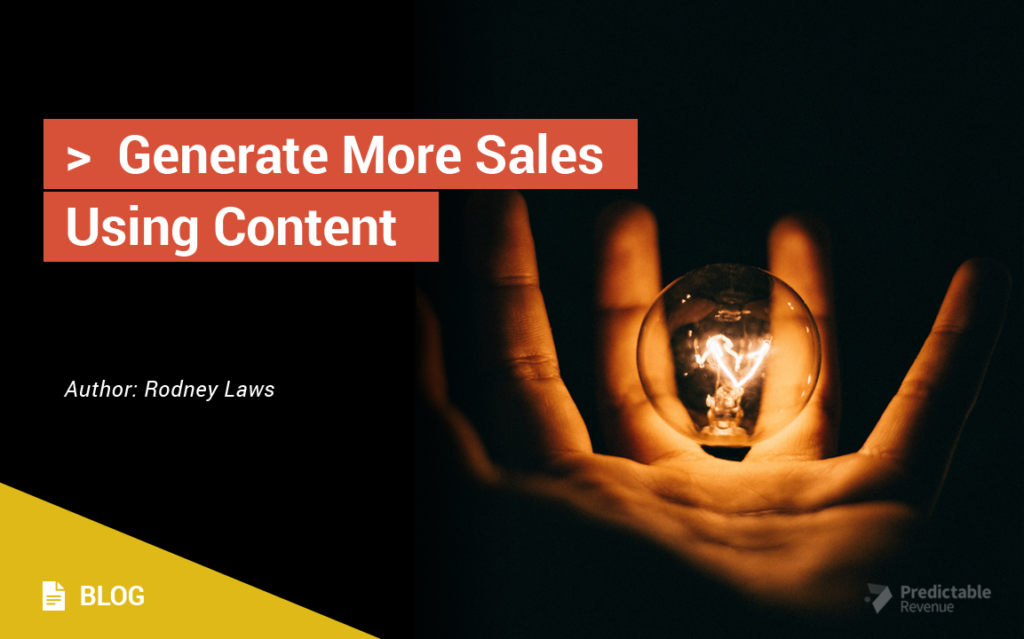How To Use Content To Generate More Sales

Author: Rodney Laws
We’ve long since passed the point at which it became a practical necessity for every company to have a brand. And now that the events of 2020 have forced businesses of all kinds to move their operations online (and caused a global recession), this should be abundantly clear to anyone paying attention. But what does it take to have a good brand? Well, there are the identifying elements such as logos and color palettes, but maybe the biggest ingredient these days is content output.
Encompassing the generation and distribution of everything from blog posts to infographics, this is the primary mechanism through which you can achieve widespread brand representation. And if you make content production a core priority, it can prove exceptionally effective at winning you sales. In this post, we’re going to run through how you can achieve this. Let’s begin.
Optimize the copy throughout your store
An often-neglected part of running an eCommerce store is writing compelling on-site copy. It’s easy to see why: all that content is often powered through at an early stage so the store can go live, with the assumption made that simply filling in the blanks adequately well is enough. This stance is informed somewhat by the template-driven nature of modern web development: platforms like Squarespace are designed to require minimal effort, with the pragmatic implication being that your store needn’t look unique: just polished. Isn’t copy the same?
Well, no, it isn’t. You can tick the boxes by getting all your product titles correct and including the key details, but there’s a world of difference between a good product description and a bland one. A decent product page will explain the benefits of the product, not just the features, and stand out from the competition. Similarly, a great homepage won’t just introduce the basics of your brand: it’ll catch the visitor’s attention and inspire them to act.
It’s a good idea to review all the content on your website, thinking carefully about how it could be improved. You can bring Google Analytics into this, paying particularly heed to pages that should be performing better than they are. And even when you’ve made some suitable edits, remember to revisit your content periodically. It will start to feel outdated and need revision.
Run a blog showing brand personality
If you don’t already have a blog, now’s the time to start one. A store blog featuring semi-frequent updates and a solid editorial tone will allow you to establish expertise in your niche, encouraging visitors to trust you. It’ll also allow you to rank for more keywords. SEO is a top priority in ecommerce since it returns exceptional value over time.
Throughout your content, don’t be afraid to take light risks. Do different things. Throw in some elements of satire or whimsy. The worst thing you can do is be boring. And provided you don’t venture into any controversial areas, you shouldn’t need to worry about social media backlash.
Carefully deploy targeted marketing emails
Just about every online seller knows about the value of sending marketing emails through services like Mailchimp, but that doesn’t mean they send good marketing emails. In fact, many of them are terrible. They’re cold, apathetic, saddled with far too many links, and sent to many of the wrong people. The result is a weak return on investment and a frustrated base of existing or prospective customers.
What you need to do is concentrate on using targeting more effectively. When you’re emailing people who’ve bought from you before, you already know they’re vaguely interested, so you don’t need to try to sell them on your brand. Instead, use what you know about them — largely what they’ve ordered before — to come up with offers that are more likely to compel them.
It’s also a good idea to run abandoned cart emails if you’re not already doing so — and if you are, then put some effort into revamping them. It’s a real shame to get someone all the way to the point of conversion only to see them walk away. If you can anticipate what’s causing people to change their minds, you can potentially convince them to return.
Build outreach assets to earn backlinks
Lastly, when ecommerce companies invest in SEO, they often forget to consider the value of backlinks. Google’s been vague on the extent to which it cares about them for quite some time, but the metrics consistently suggest that having a strong backlink profile (you can check this through a service like Ahrefs) is very important for getting your website high in the rankings.
As noted, one result of producing good content for your blog will be the strengthening of the perceived expertise of your brand. You can draw upon that for outreach. If you create content that high-quality sites will want to post — typically charts or infographics — then you can send it to them with just one request: to give you attribution in the form of a link.
SEO isn’t the only benefit, though. If your content concentrates on a product you offer, then each link you pick up will allow you to get visits directly from interested shoppers. If you choose the target sites correctly, this approach can pay off massively.
Wrapping up, the production of excellent content can hugely improve your sales figures if you know how to take advantage of it. By optimizing your store and creating further content to attract visits, you can give your business a serious boost.